Monetary Policy and Economic Relations: Australia Assignment
VerifiedAdded on 2020/03/16
|22
|3517
|52
Report
AI Summary
This report provides a comprehensive analysis of monetary policy in Australia, focusing on the Reserve Bank of Australia (RBA) and its influence on the economy. It examines the objectives of monetary policy, including price stability, full employment, and exchange rate stability. The report details the main functions of the RBA, such as maintaining currency stability and managing the financial system. It explores Australia's economic relations with China and the USA, highlighting the interdependence and trade dynamics between these nations. The report further delves into the money market equilibrium and the monetary transmission mechanism, illustrating how changes in the cash rate affect the economy. It also provides an overview of key economic indicators, including GDP, unemployment, inflation, fiscal deficit, and housing prices, over the past five years, to assess the effectiveness of monetary policy. The analysis includes graphical representations of these indicators and concludes with an assessment of the current economic scenario and the RBA's decisions regarding the cash rate.
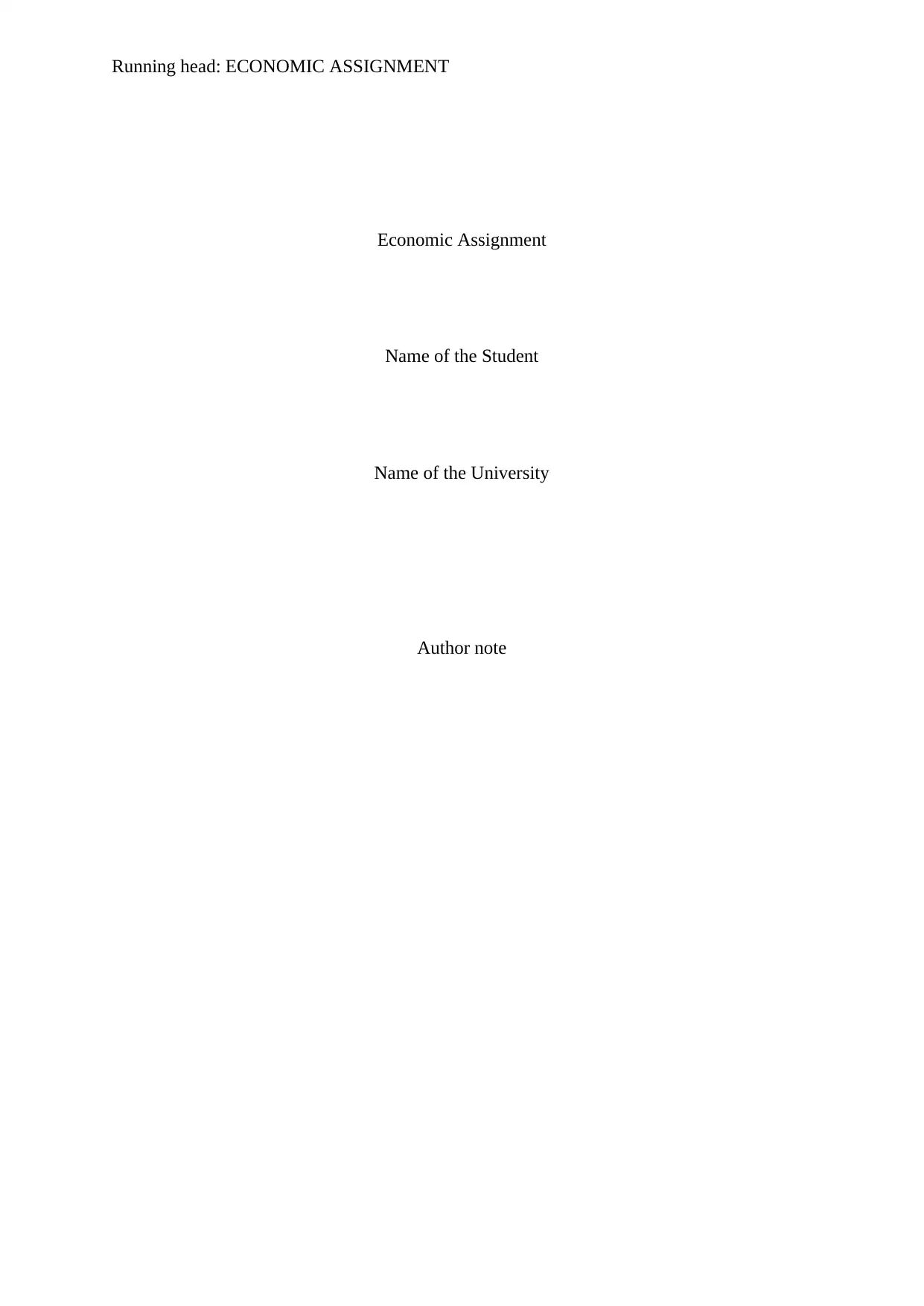
Running head: ECONOMIC ASSIGNMENT
Economic Assignment
Name of the Student
Name of the University
Author note
Economic Assignment
Name of the Student
Name of the University
Author note
Paraphrase This Document
Need a fresh take? Get an instant paraphrase of this document with our AI Paraphraser
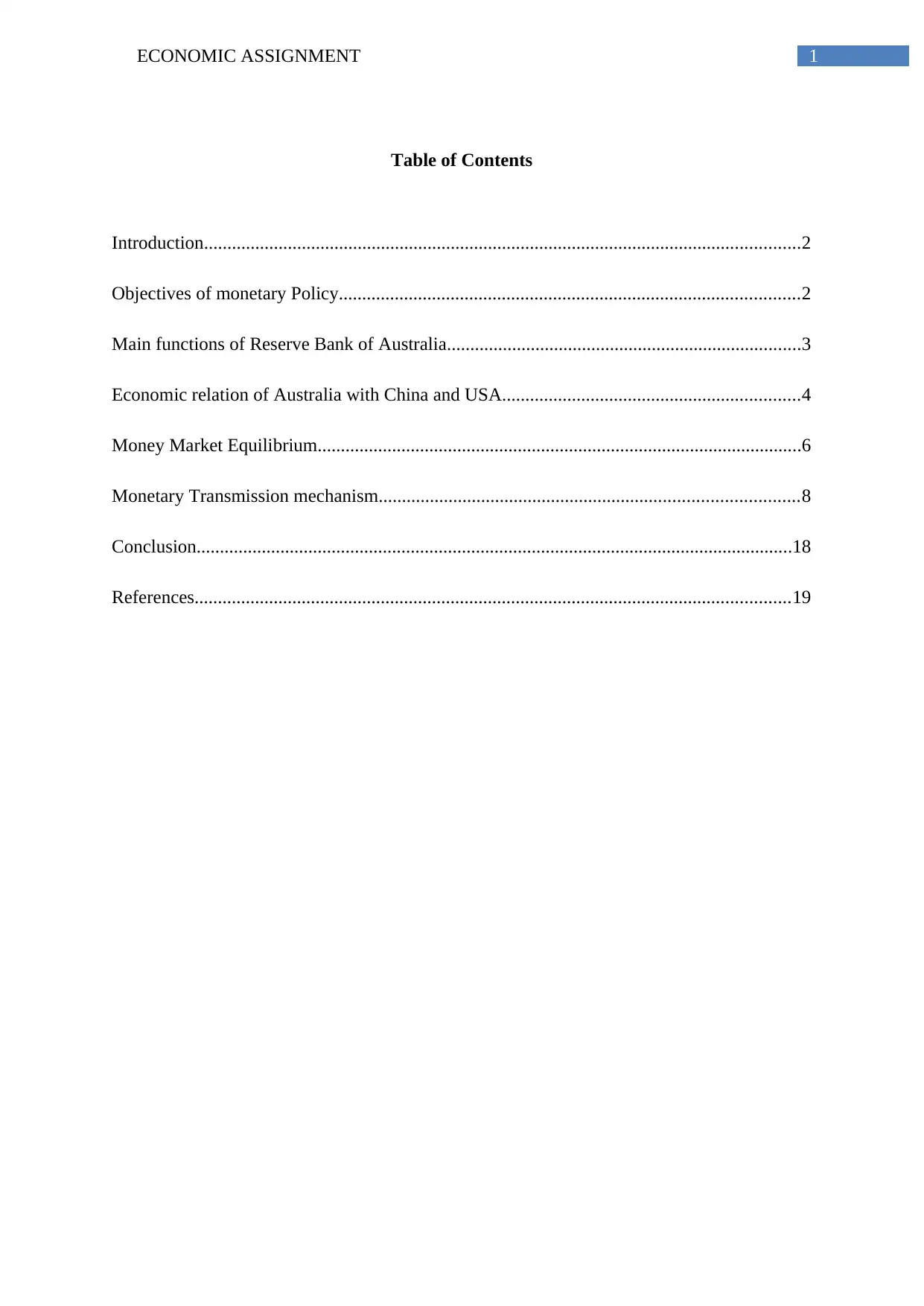
1ECONOMIC ASSIGNMENT
Table of Contents
Introduction................................................................................................................................2
Objectives of monetary Policy...................................................................................................2
Main functions of Reserve Bank of Australia............................................................................3
Economic relation of Australia with China and USA................................................................4
Money Market Equilibrium........................................................................................................6
Monetary Transmission mechanism..........................................................................................8
Conclusion................................................................................................................................18
References................................................................................................................................19
Table of Contents
Introduction................................................................................................................................2
Objectives of monetary Policy...................................................................................................2
Main functions of Reserve Bank of Australia............................................................................3
Economic relation of Australia with China and USA................................................................4
Money Market Equilibrium........................................................................................................6
Monetary Transmission mechanism..........................................................................................8
Conclusion................................................................................................................................18
References................................................................................................................................19
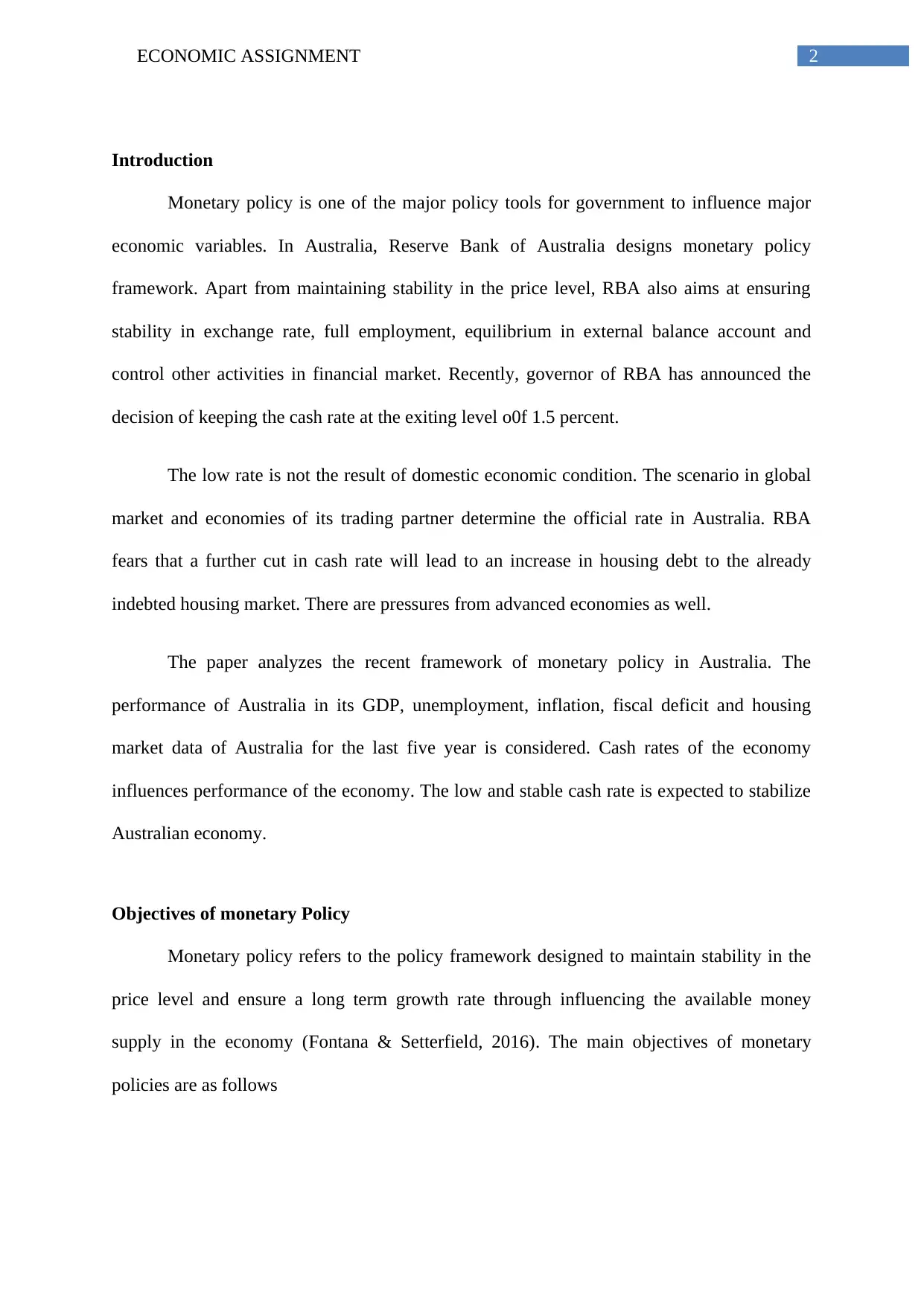
2ECONOMIC ASSIGNMENT
Introduction
Monetary policy is one of the major policy tools for government to influence major
economic variables. In Australia, Reserve Bank of Australia designs monetary policy
framework. Apart from maintaining stability in the price level, RBA also aims at ensuring
stability in exchange rate, full employment, equilibrium in external balance account and
control other activities in financial market. Recently, governor of RBA has announced the
decision of keeping the cash rate at the exiting level o0f 1.5 percent.
The low rate is not the result of domestic economic condition. The scenario in global
market and economies of its trading partner determine the official rate in Australia. RBA
fears that a further cut in cash rate will lead to an increase in housing debt to the already
indebted housing market. There are pressures from advanced economies as well.
The paper analyzes the recent framework of monetary policy in Australia. The
performance of Australia in its GDP, unemployment, inflation, fiscal deficit and housing
market data of Australia for the last five year is considered. Cash rates of the economy
influences performance of the economy. The low and stable cash rate is expected to stabilize
Australian economy.
Objectives of monetary Policy
Monetary policy refers to the policy framework designed to maintain stability in the
price level and ensure a long term growth rate through influencing the available money
supply in the economy (Fontana & Setterfield, 2016). The main objectives of monetary
policies are as follows
Introduction
Monetary policy is one of the major policy tools for government to influence major
economic variables. In Australia, Reserve Bank of Australia designs monetary policy
framework. Apart from maintaining stability in the price level, RBA also aims at ensuring
stability in exchange rate, full employment, equilibrium in external balance account and
control other activities in financial market. Recently, governor of RBA has announced the
decision of keeping the cash rate at the exiting level o0f 1.5 percent.
The low rate is not the result of domestic economic condition. The scenario in global
market and economies of its trading partner determine the official rate in Australia. RBA
fears that a further cut in cash rate will lead to an increase in housing debt to the already
indebted housing market. There are pressures from advanced economies as well.
The paper analyzes the recent framework of monetary policy in Australia. The
performance of Australia in its GDP, unemployment, inflation, fiscal deficit and housing
market data of Australia for the last five year is considered. Cash rates of the economy
influences performance of the economy. The low and stable cash rate is expected to stabilize
Australian economy.
Objectives of monetary Policy
Monetary policy refers to the policy framework designed to maintain stability in the
price level and ensure a long term growth rate through influencing the available money
supply in the economy (Fontana & Setterfield, 2016). The main objectives of monetary
policies are as follows
⊘ This is a preview!⊘
Do you want full access?
Subscribe today to unlock all pages.

Trusted by 1+ million students worldwide
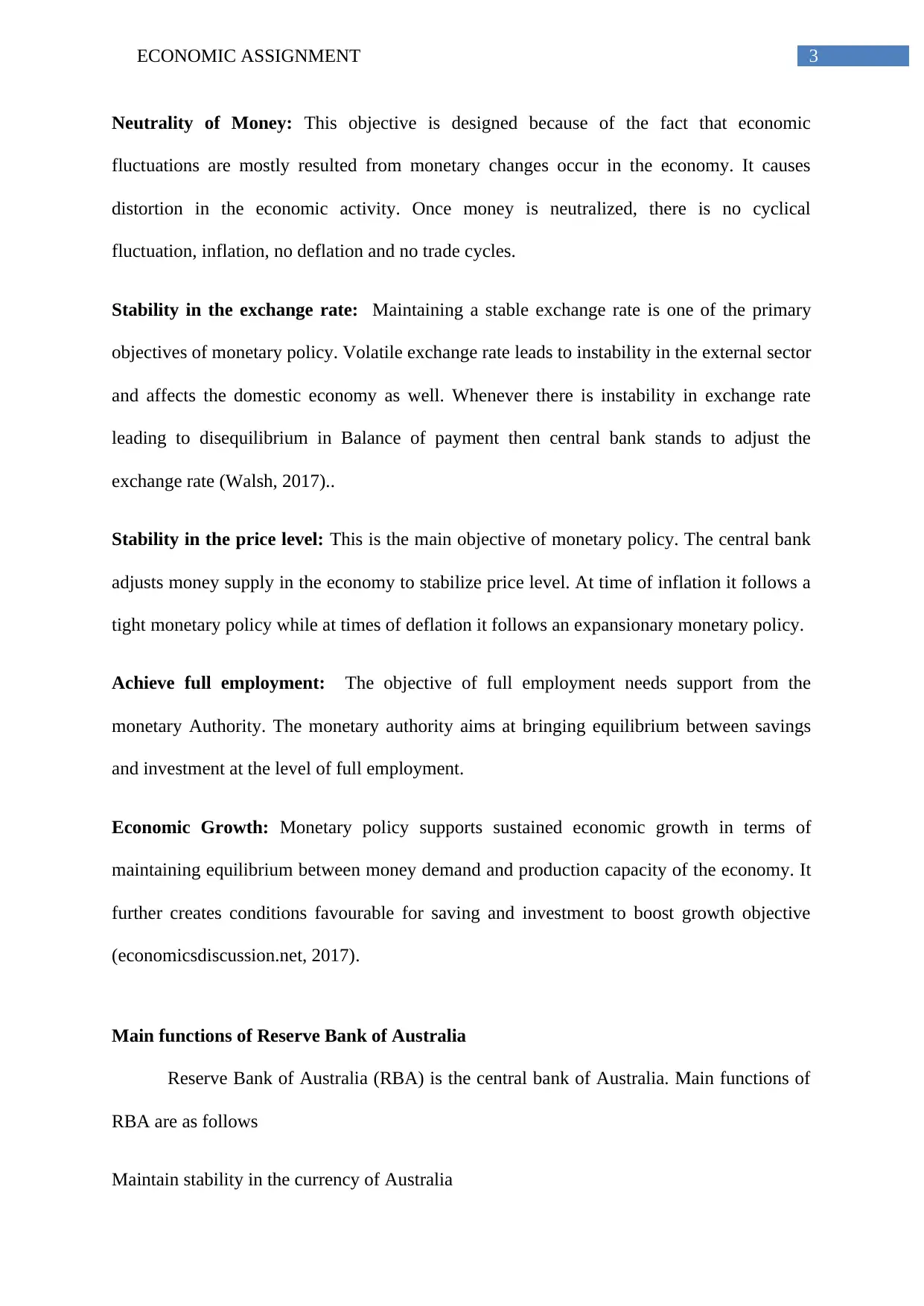
3ECONOMIC ASSIGNMENT
Neutrality of Money: This objective is designed because of the fact that economic
fluctuations are mostly resulted from monetary changes occur in the economy. It causes
distortion in the economic activity. Once money is neutralized, there is no cyclical
fluctuation, inflation, no deflation and no trade cycles.
Stability in the exchange rate: Maintaining a stable exchange rate is one of the primary
objectives of monetary policy. Volatile exchange rate leads to instability in the external sector
and affects the domestic economy as well. Whenever there is instability in exchange rate
leading to disequilibrium in Balance of payment then central bank stands to adjust the
exchange rate (Walsh, 2017)..
Stability in the price level: This is the main objective of monetary policy. The central bank
adjusts money supply in the economy to stabilize price level. At time of inflation it follows a
tight monetary policy while at times of deflation it follows an expansionary monetary policy.
Achieve full employment: The objective of full employment needs support from the
monetary Authority. The monetary authority aims at bringing equilibrium between savings
and investment at the level of full employment.
Economic Growth: Monetary policy supports sustained economic growth in terms of
maintaining equilibrium between money demand and production capacity of the economy. It
further creates conditions favourable for saving and investment to boost growth objective
(economicsdiscussion.net, 2017).
Main functions of Reserve Bank of Australia
Reserve Bank of Australia (RBA) is the central bank of Australia. Main functions of
RBA are as follows
Maintain stability in the currency of Australia
Neutrality of Money: This objective is designed because of the fact that economic
fluctuations are mostly resulted from monetary changes occur in the economy. It causes
distortion in the economic activity. Once money is neutralized, there is no cyclical
fluctuation, inflation, no deflation and no trade cycles.
Stability in the exchange rate: Maintaining a stable exchange rate is one of the primary
objectives of monetary policy. Volatile exchange rate leads to instability in the external sector
and affects the domestic economy as well. Whenever there is instability in exchange rate
leading to disequilibrium in Balance of payment then central bank stands to adjust the
exchange rate (Walsh, 2017)..
Stability in the price level: This is the main objective of monetary policy. The central bank
adjusts money supply in the economy to stabilize price level. At time of inflation it follows a
tight monetary policy while at times of deflation it follows an expansionary monetary policy.
Achieve full employment: The objective of full employment needs support from the
monetary Authority. The monetary authority aims at bringing equilibrium between savings
and investment at the level of full employment.
Economic Growth: Monetary policy supports sustained economic growth in terms of
maintaining equilibrium between money demand and production capacity of the economy. It
further creates conditions favourable for saving and investment to boost growth objective
(economicsdiscussion.net, 2017).
Main functions of Reserve Bank of Australia
Reserve Bank of Australia (RBA) is the central bank of Australia. Main functions of
RBA are as follows
Maintain stability in the currency of Australia
Paraphrase This Document
Need a fresh take? Get an instant paraphrase of this document with our AI Paraphraser
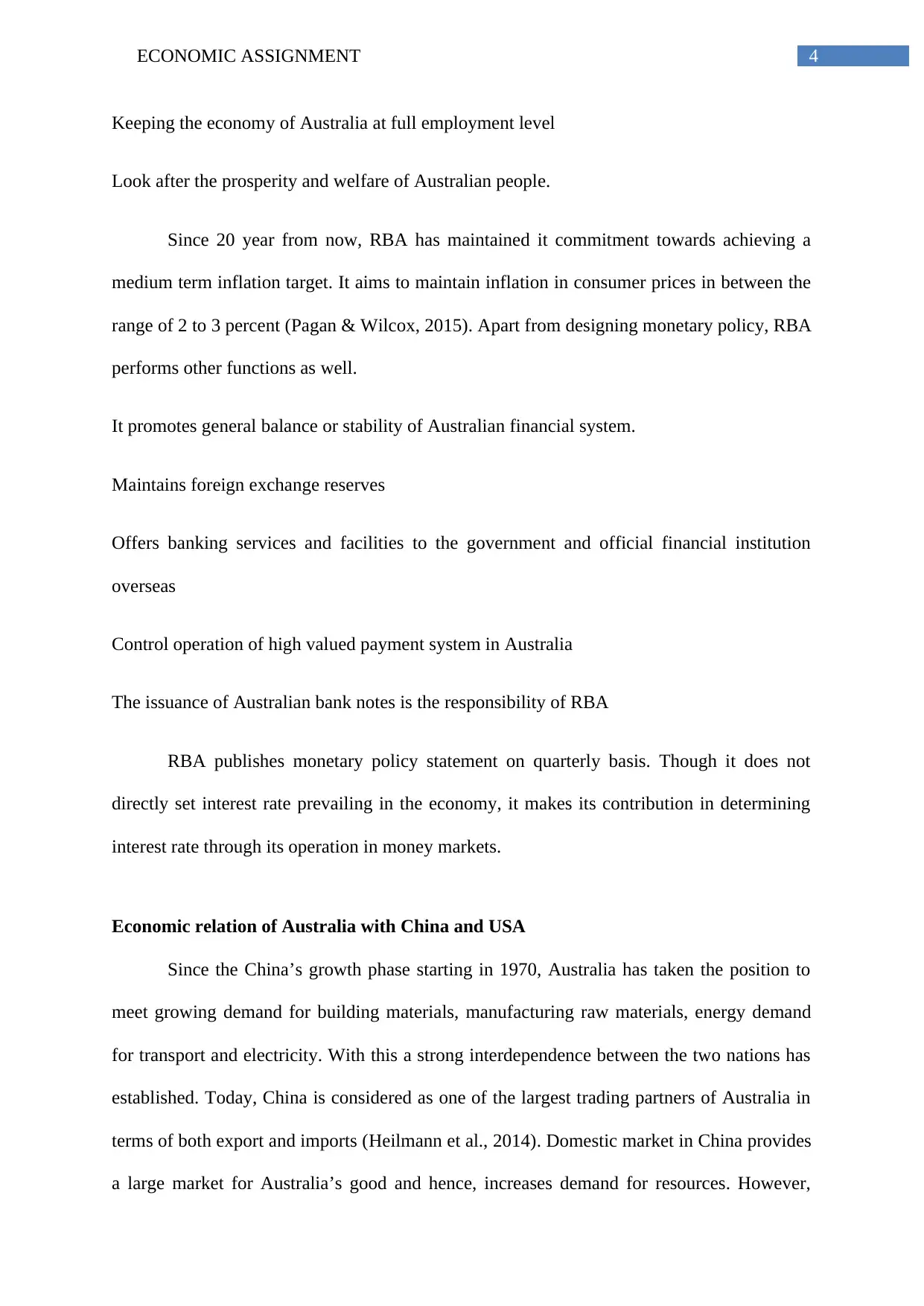
4ECONOMIC ASSIGNMENT
Keeping the economy of Australia at full employment level
Look after the prosperity and welfare of Australian people.
Since 20 year from now, RBA has maintained it commitment towards achieving a
medium term inflation target. It aims to maintain inflation in consumer prices in between the
range of 2 to 3 percent (Pagan & Wilcox, 2015). Apart from designing monetary policy, RBA
performs other functions as well.
It promotes general balance or stability of Australian financial system.
Maintains foreign exchange reserves
Offers banking services and facilities to the government and official financial institution
overseas
Control operation of high valued payment system in Australia
The issuance of Australian bank notes is the responsibility of RBA
RBA publishes monetary policy statement on quarterly basis. Though it does not
directly set interest rate prevailing in the economy, it makes its contribution in determining
interest rate through its operation in money markets.
Economic relation of Australia with China and USA
Since the China’s growth phase starting in 1970, Australia has taken the position to
meet growing demand for building materials, manufacturing raw materials, energy demand
for transport and electricity. With this a strong interdependence between the two nations has
established. Today, China is considered as one of the largest trading partners of Australia in
terms of both export and imports (Heilmann et al., 2014). Domestic market in China provides
a large market for Australia’s good and hence, increases demand for resources. However,
Keeping the economy of Australia at full employment level
Look after the prosperity and welfare of Australian people.
Since 20 year from now, RBA has maintained it commitment towards achieving a
medium term inflation target. It aims to maintain inflation in consumer prices in between the
range of 2 to 3 percent (Pagan & Wilcox, 2015). Apart from designing monetary policy, RBA
performs other functions as well.
It promotes general balance or stability of Australian financial system.
Maintains foreign exchange reserves
Offers banking services and facilities to the government and official financial institution
overseas
Control operation of high valued payment system in Australia
The issuance of Australian bank notes is the responsibility of RBA
RBA publishes monetary policy statement on quarterly basis. Though it does not
directly set interest rate prevailing in the economy, it makes its contribution in determining
interest rate through its operation in money markets.
Economic relation of Australia with China and USA
Since the China’s growth phase starting in 1970, Australia has taken the position to
meet growing demand for building materials, manufacturing raw materials, energy demand
for transport and electricity. With this a strong interdependence between the two nations has
established. Today, China is considered as one of the largest trading partners of Australia in
terms of both export and imports (Heilmann et al., 2014). Domestic market in China provides
a large market for Australia’s good and hence, increases demand for resources. However,
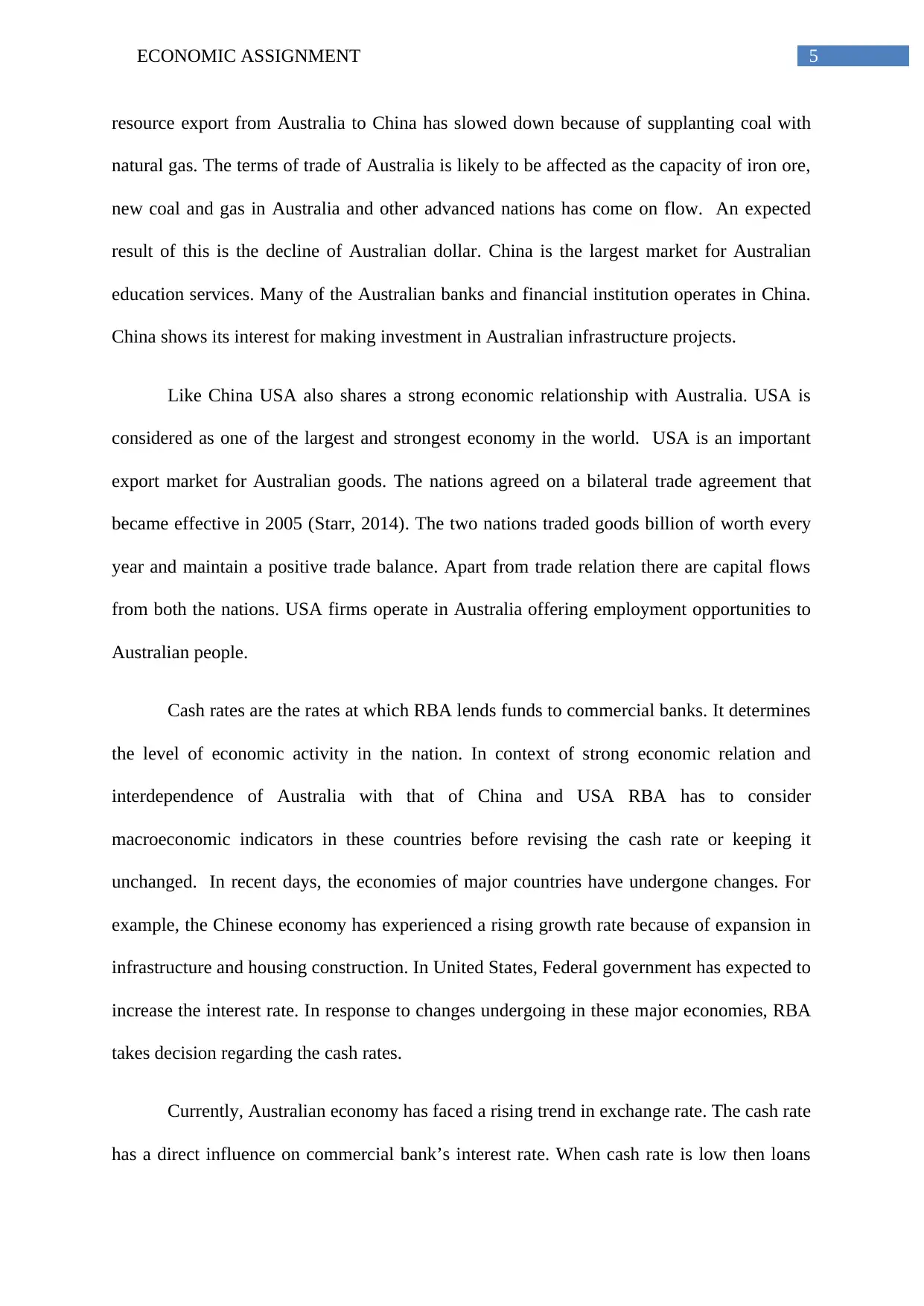
5ECONOMIC ASSIGNMENT
resource export from Australia to China has slowed down because of supplanting coal with
natural gas. The terms of trade of Australia is likely to be affected as the capacity of iron ore,
new coal and gas in Australia and other advanced nations has come on flow. An expected
result of this is the decline of Australian dollar. China is the largest market for Australian
education services. Many of the Australian banks and financial institution operates in China.
China shows its interest for making investment in Australian infrastructure projects.
Like China USA also shares a strong economic relationship with Australia. USA is
considered as one of the largest and strongest economy in the world. USA is an important
export market for Australian goods. The nations agreed on a bilateral trade agreement that
became effective in 2005 (Starr, 2014). The two nations traded goods billion of worth every
year and maintain a positive trade balance. Apart from trade relation there are capital flows
from both the nations. USA firms operate in Australia offering employment opportunities to
Australian people.
Cash rates are the rates at which RBA lends funds to commercial banks. It determines
the level of economic activity in the nation. In context of strong economic relation and
interdependence of Australia with that of China and USA RBA has to consider
macroeconomic indicators in these countries before revising the cash rate or keeping it
unchanged. In recent days, the economies of major countries have undergone changes. For
example, the Chinese economy has experienced a rising growth rate because of expansion in
infrastructure and housing construction. In United States, Federal government has expected to
increase the interest rate. In response to changes undergoing in these major economies, RBA
takes decision regarding the cash rates.
Currently, Australian economy has faced a rising trend in exchange rate. The cash rate
has a direct influence on commercial bank’s interest rate. When cash rate is low then loans
resource export from Australia to China has slowed down because of supplanting coal with
natural gas. The terms of trade of Australia is likely to be affected as the capacity of iron ore,
new coal and gas in Australia and other advanced nations has come on flow. An expected
result of this is the decline of Australian dollar. China is the largest market for Australian
education services. Many of the Australian banks and financial institution operates in China.
China shows its interest for making investment in Australian infrastructure projects.
Like China USA also shares a strong economic relationship with Australia. USA is
considered as one of the largest and strongest economy in the world. USA is an important
export market for Australian goods. The nations agreed on a bilateral trade agreement that
became effective in 2005 (Starr, 2014). The two nations traded goods billion of worth every
year and maintain a positive trade balance. Apart from trade relation there are capital flows
from both the nations. USA firms operate in Australia offering employment opportunities to
Australian people.
Cash rates are the rates at which RBA lends funds to commercial banks. It determines
the level of economic activity in the nation. In context of strong economic relation and
interdependence of Australia with that of China and USA RBA has to consider
macroeconomic indicators in these countries before revising the cash rate or keeping it
unchanged. In recent days, the economies of major countries have undergone changes. For
example, the Chinese economy has experienced a rising growth rate because of expansion in
infrastructure and housing construction. In United States, Federal government has expected to
increase the interest rate. In response to changes undergoing in these major economies, RBA
takes decision regarding the cash rates.
Currently, Australian economy has faced a rising trend in exchange rate. The cash rate
has a direct influence on commercial bank’s interest rate. When cash rate is low then loans
⊘ This is a preview!⊘
Do you want full access?
Subscribe today to unlock all pages.

Trusted by 1+ million students worldwide
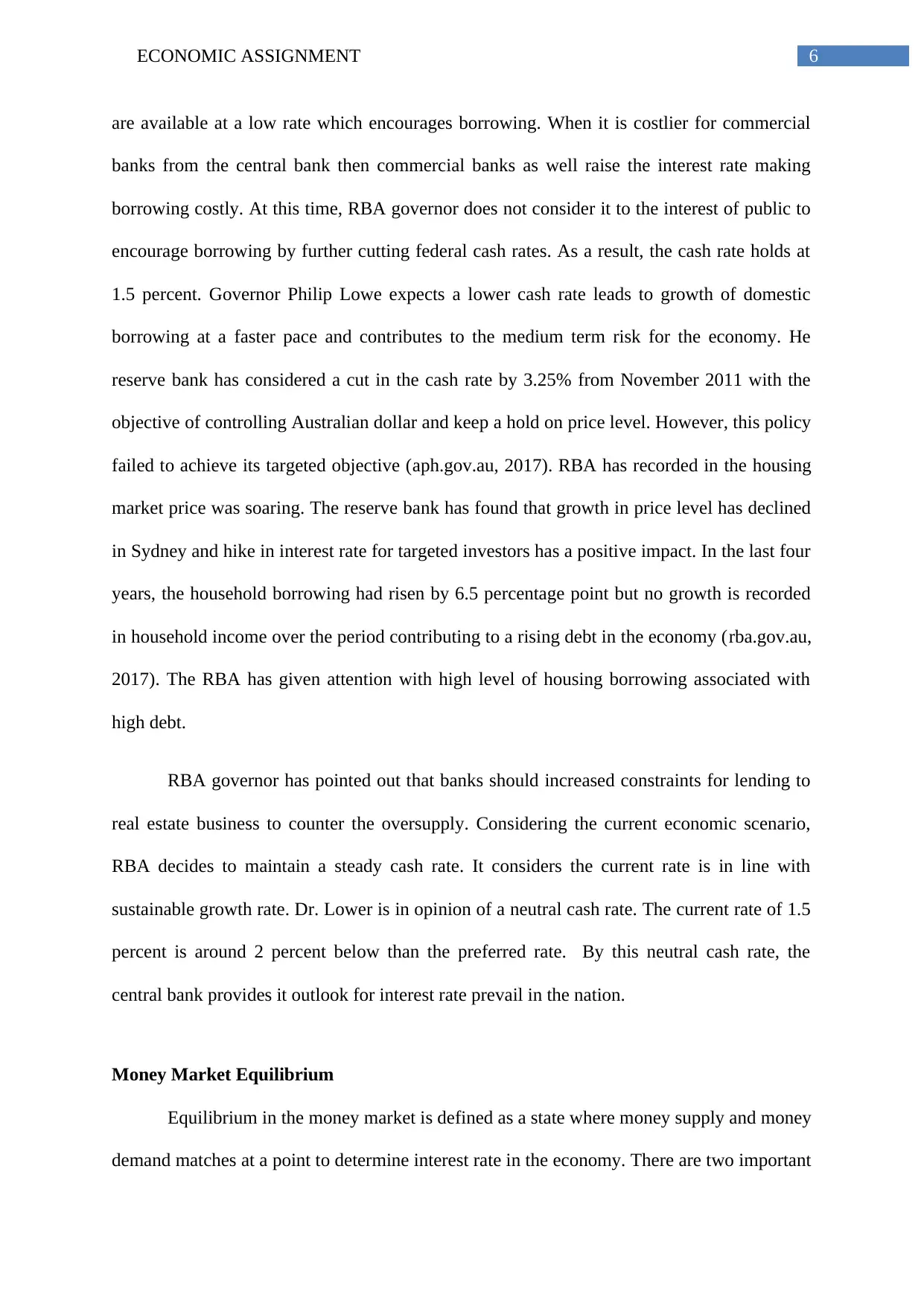
6ECONOMIC ASSIGNMENT
are available at a low rate which encourages borrowing. When it is costlier for commercial
banks from the central bank then commercial banks as well raise the interest rate making
borrowing costly. At this time, RBA governor does not consider it to the interest of public to
encourage borrowing by further cutting federal cash rates. As a result, the cash rate holds at
1.5 percent. Governor Philip Lowe expects a lower cash rate leads to growth of domestic
borrowing at a faster pace and contributes to the medium term risk for the economy. He
reserve bank has considered a cut in the cash rate by 3.25% from November 2011 with the
objective of controlling Australian dollar and keep a hold on price level. However, this policy
failed to achieve its targeted objective (aph.gov.au, 2017). RBA has recorded in the housing
market price was soaring. The reserve bank has found that growth in price level has declined
in Sydney and hike in interest rate for targeted investors has a positive impact. In the last four
years, the household borrowing had risen by 6.5 percentage point but no growth is recorded
in household income over the period contributing to a rising debt in the economy (rba.gov.au,
2017). The RBA has given attention with high level of housing borrowing associated with
high debt.
RBA governor has pointed out that banks should increased constraints for lending to
real estate business to counter the oversupply. Considering the current economic scenario,
RBA decides to maintain a steady cash rate. It considers the current rate is in line with
sustainable growth rate. Dr. Lower is in opinion of a neutral cash rate. The current rate of 1.5
percent is around 2 percent below than the preferred rate. By this neutral cash rate, the
central bank provides it outlook for interest rate prevail in the nation.
Money Market Equilibrium
Equilibrium in the money market is defined as a state where money supply and money
demand matches at a point to determine interest rate in the economy. There are two important
are available at a low rate which encourages borrowing. When it is costlier for commercial
banks from the central bank then commercial banks as well raise the interest rate making
borrowing costly. At this time, RBA governor does not consider it to the interest of public to
encourage borrowing by further cutting federal cash rates. As a result, the cash rate holds at
1.5 percent. Governor Philip Lowe expects a lower cash rate leads to growth of domestic
borrowing at a faster pace and contributes to the medium term risk for the economy. He
reserve bank has considered a cut in the cash rate by 3.25% from November 2011 with the
objective of controlling Australian dollar and keep a hold on price level. However, this policy
failed to achieve its targeted objective (aph.gov.au, 2017). RBA has recorded in the housing
market price was soaring. The reserve bank has found that growth in price level has declined
in Sydney and hike in interest rate for targeted investors has a positive impact. In the last four
years, the household borrowing had risen by 6.5 percentage point but no growth is recorded
in household income over the period contributing to a rising debt in the economy (rba.gov.au,
2017). The RBA has given attention with high level of housing borrowing associated with
high debt.
RBA governor has pointed out that banks should increased constraints for lending to
real estate business to counter the oversupply. Considering the current economic scenario,
RBA decides to maintain a steady cash rate. It considers the current rate is in line with
sustainable growth rate. Dr. Lower is in opinion of a neutral cash rate. The current rate of 1.5
percent is around 2 percent below than the preferred rate. By this neutral cash rate, the
central bank provides it outlook for interest rate prevail in the nation.
Money Market Equilibrium
Equilibrium in the money market is defined as a state where money supply and money
demand matches at a point to determine interest rate in the economy. There are two important
Paraphrase This Document
Need a fresh take? Get an instant paraphrase of this document with our AI Paraphraser
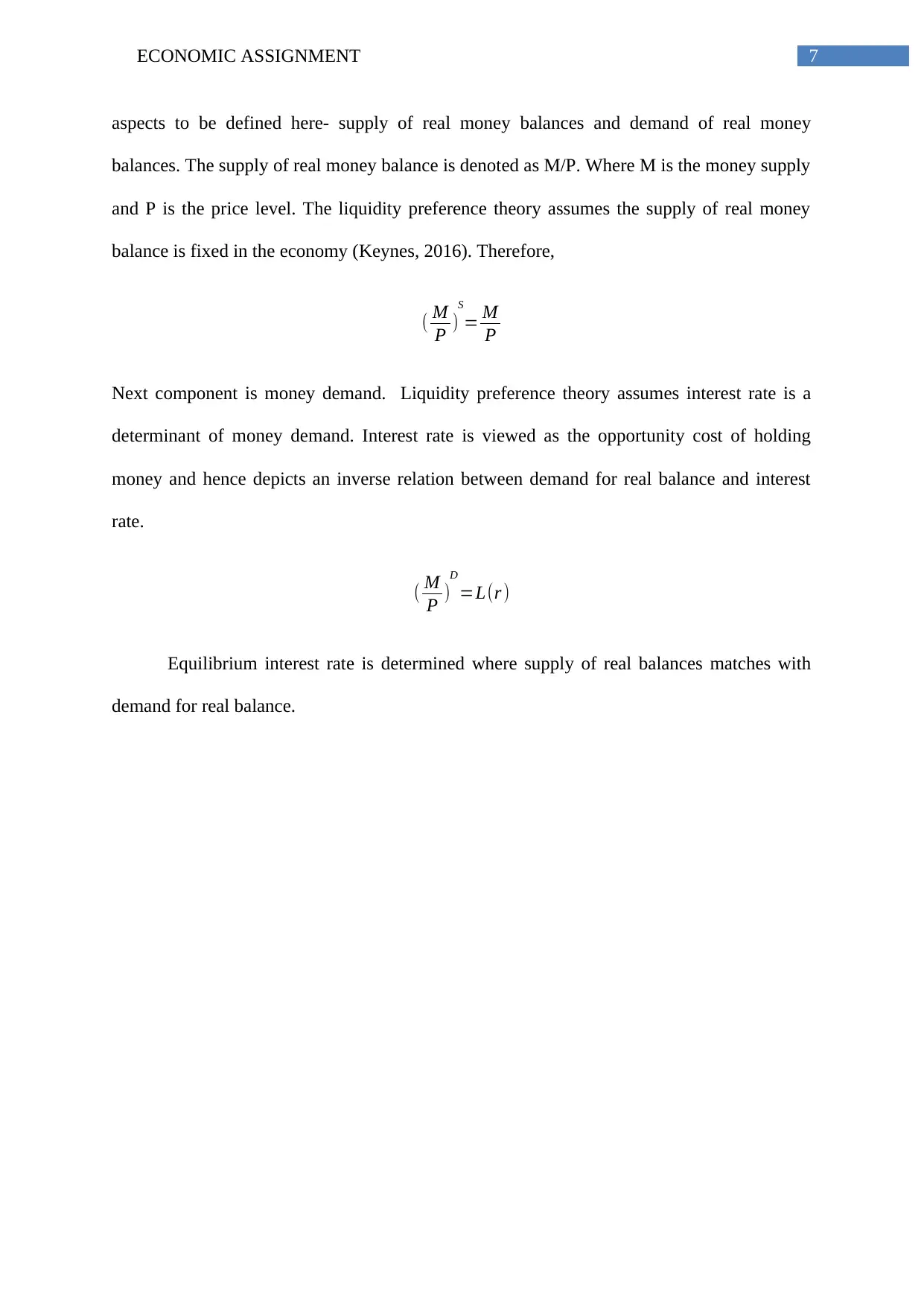
7ECONOMIC ASSIGNMENT
aspects to be defined here- supply of real money balances and demand of real money
balances. The supply of real money balance is denoted as M/P. Where M is the money supply
and P is the price level. The liquidity preference theory assumes the supply of real money
balance is fixed in the economy (Keynes, 2016). Therefore,
( M
P )
S
= M
P
Next component is money demand. Liquidity preference theory assumes interest rate is a
determinant of money demand. Interest rate is viewed as the opportunity cost of holding
money and hence depicts an inverse relation between demand for real balance and interest
rate.
( M
P )
D
=L(r )
Equilibrium interest rate is determined where supply of real balances matches with
demand for real balance.
aspects to be defined here- supply of real money balances and demand of real money
balances. The supply of real money balance is denoted as M/P. Where M is the money supply
and P is the price level. The liquidity preference theory assumes the supply of real money
balance is fixed in the economy (Keynes, 2016). Therefore,
( M
P )
S
= M
P
Next component is money demand. Liquidity preference theory assumes interest rate is a
determinant of money demand. Interest rate is viewed as the opportunity cost of holding
money and hence depicts an inverse relation between demand for real balance and interest
rate.
( M
P )
D
=L(r )
Equilibrium interest rate is determined where supply of real balances matches with
demand for real balance.
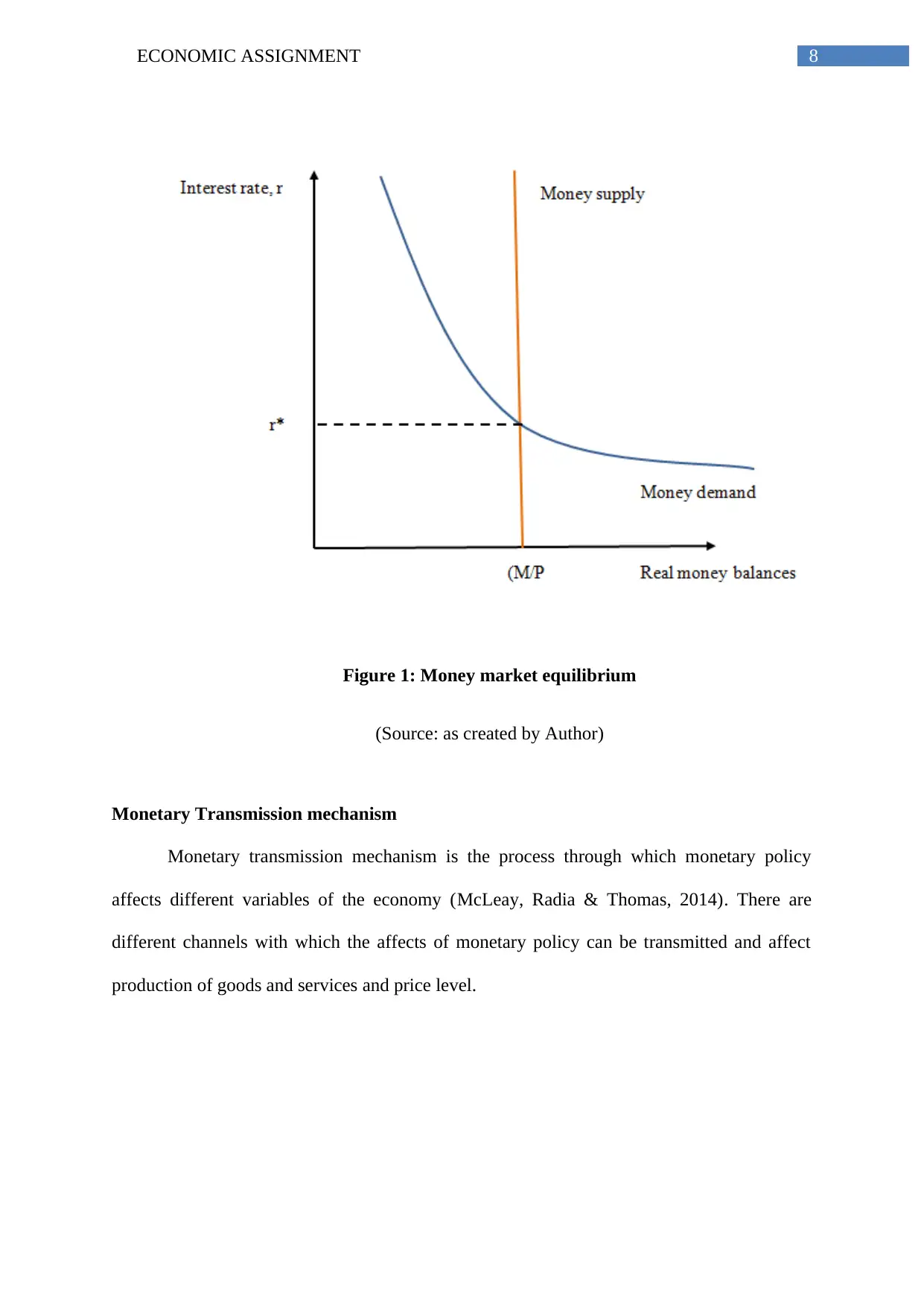
8ECONOMIC ASSIGNMENT
Figure 1: Money market equilibrium
(Source: as created by Author)
Monetary Transmission mechanism
Monetary transmission mechanism is the process through which monetary policy
affects different variables of the economy (McLeay, Radia & Thomas, 2014). There are
different channels with which the affects of monetary policy can be transmitted and affect
production of goods and services and price level.
Figure 1: Money market equilibrium
(Source: as created by Author)
Monetary Transmission mechanism
Monetary transmission mechanism is the process through which monetary policy
affects different variables of the economy (McLeay, Radia & Thomas, 2014). There are
different channels with which the affects of monetary policy can be transmitted and affect
production of goods and services and price level.
⊘ This is a preview!⊘
Do you want full access?
Subscribe today to unlock all pages.

Trusted by 1+ million students worldwide
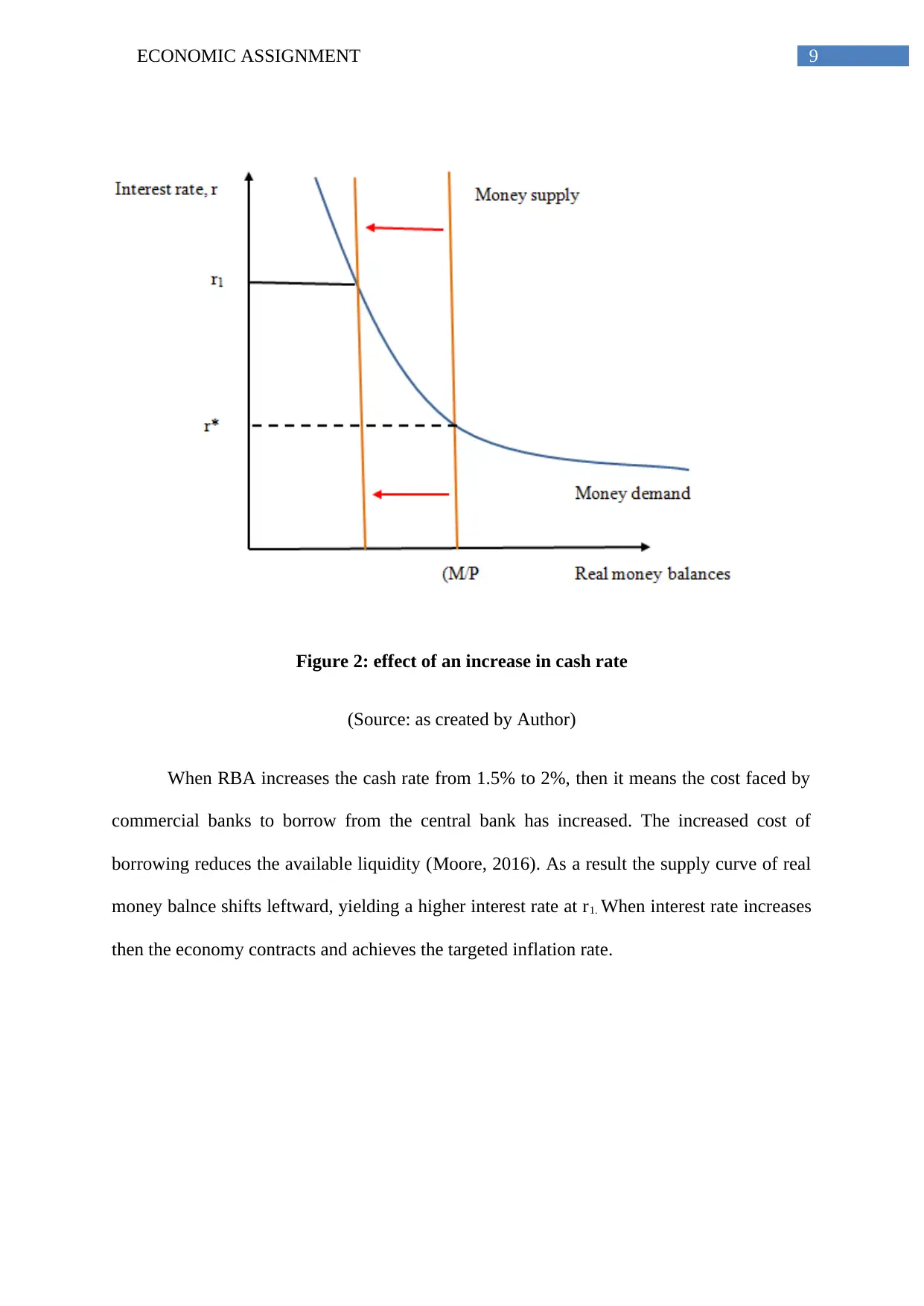
9ECONOMIC ASSIGNMENT
Figure 2: effect of an increase in cash rate
(Source: as created by Author)
When RBA increases the cash rate from 1.5% to 2%, then it means the cost faced by
commercial banks to borrow from the central bank has increased. The increased cost of
borrowing reduces the available liquidity (Moore, 2016). As a result the supply curve of real
money balnce shifts leftward, yielding a higher interest rate at r1. When interest rate increases
then the economy contracts and achieves the targeted inflation rate.
Figure 2: effect of an increase in cash rate
(Source: as created by Author)
When RBA increases the cash rate from 1.5% to 2%, then it means the cost faced by
commercial banks to borrow from the central bank has increased. The increased cost of
borrowing reduces the available liquidity (Moore, 2016). As a result the supply curve of real
money balnce shifts leftward, yielding a higher interest rate at r1. When interest rate increases
then the economy contracts and achieves the targeted inflation rate.
Paraphrase This Document
Need a fresh take? Get an instant paraphrase of this document with our AI Paraphraser
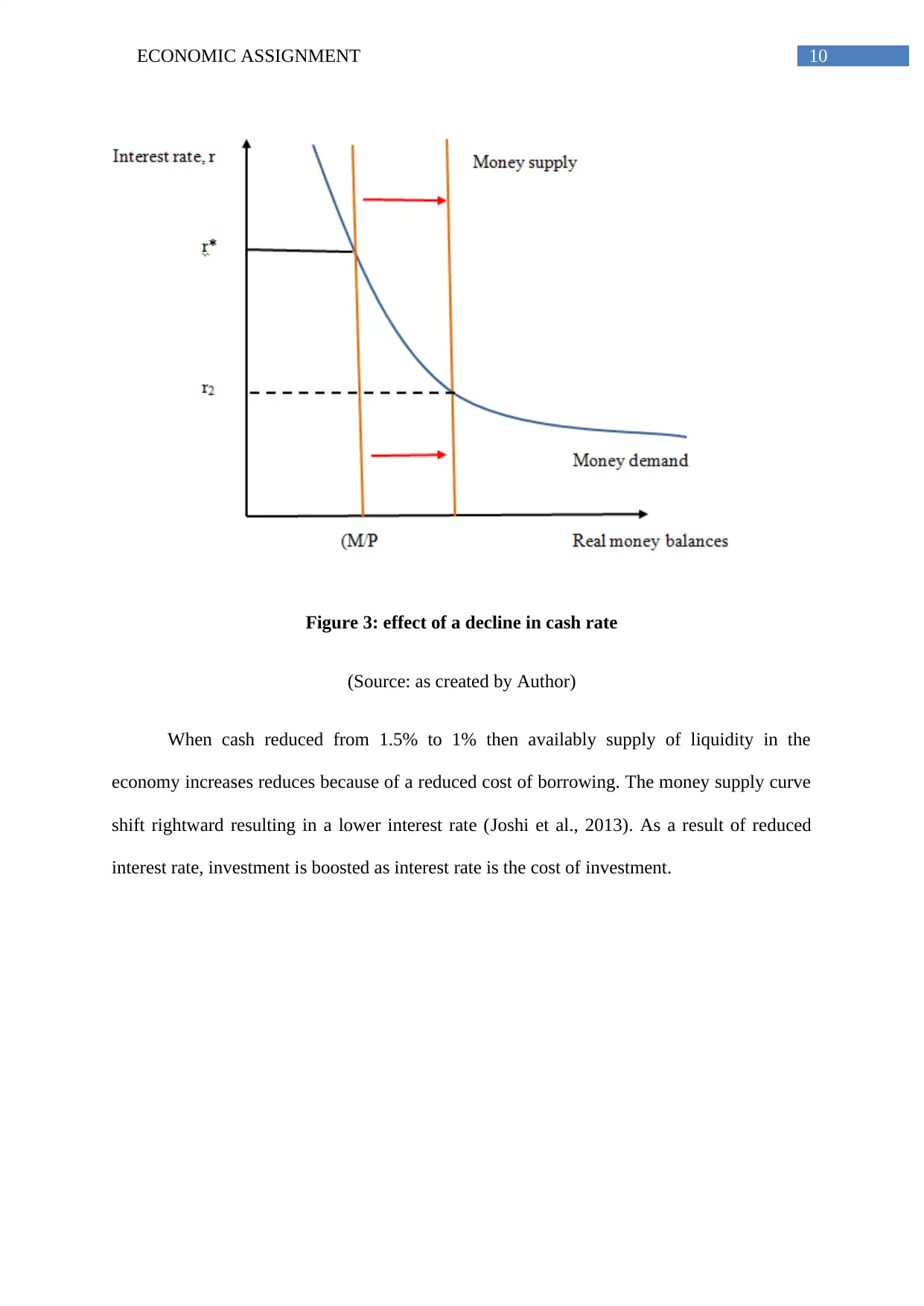
10ECONOMIC ASSIGNMENT
Figure 3: effect of a decline in cash rate
(Source: as created by Author)
When cash reduced from 1.5% to 1% then availably supply of liquidity in the
economy increases reduces because of a reduced cost of borrowing. The money supply curve
shift rightward resulting in a lower interest rate (Joshi et al., 2013). As a result of reduced
interest rate, investment is boosted as interest rate is the cost of investment.
Figure 3: effect of a decline in cash rate
(Source: as created by Author)
When cash reduced from 1.5% to 1% then availably supply of liquidity in the
economy increases reduces because of a reduced cost of borrowing. The money supply curve
shift rightward resulting in a lower interest rate (Joshi et al., 2013). As a result of reduced
interest rate, investment is boosted as interest rate is the cost of investment.
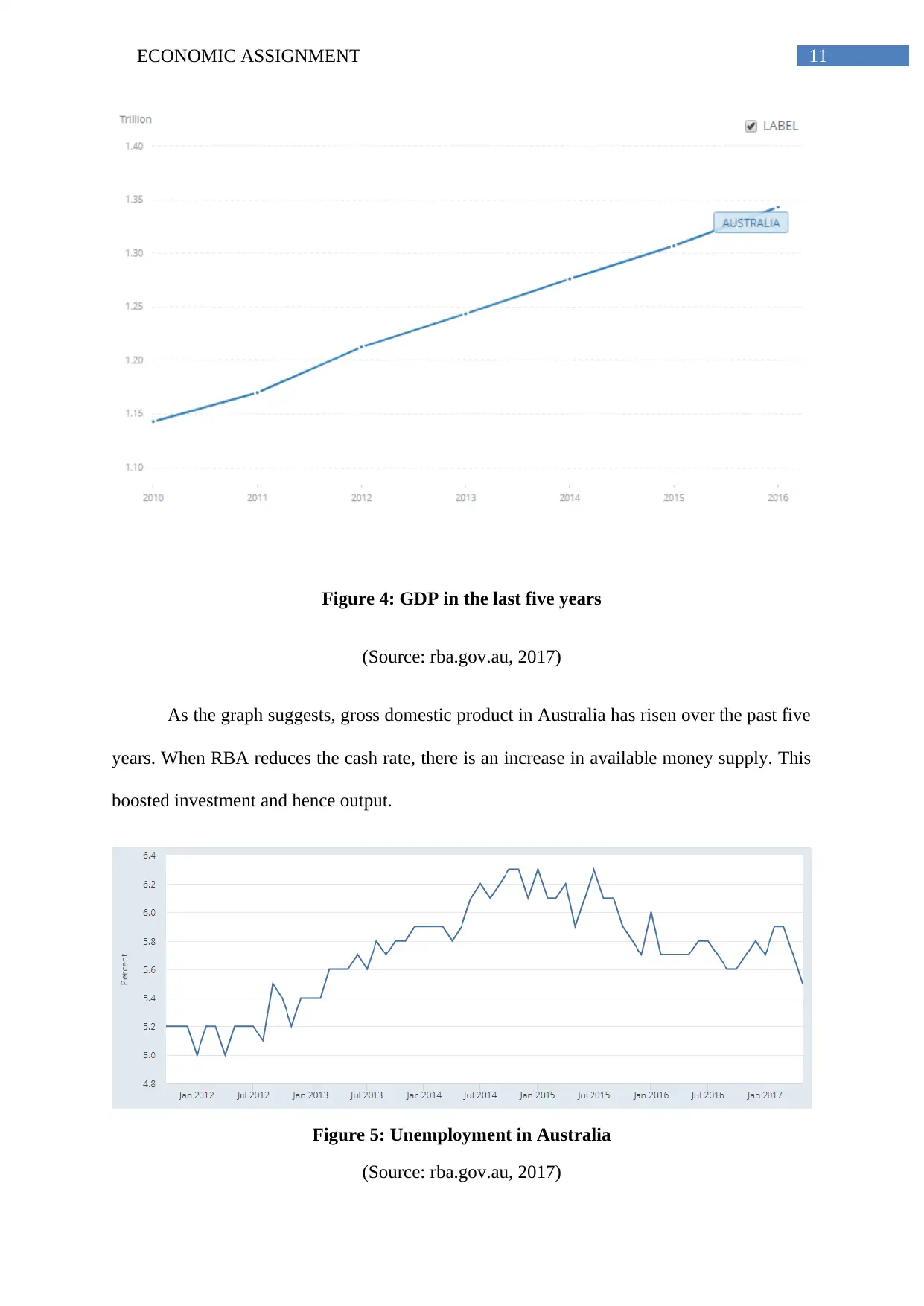
11ECONOMIC ASSIGNMENT
Figure 4: GDP in the last five years
(Source: rba.gov.au, 2017)
As the graph suggests, gross domestic product in Australia has risen over the past five
years. When RBA reduces the cash rate, there is an increase in available money supply. This
boosted investment and hence output.
Figure 5: Unemployment in Australia
(Source: rba.gov.au, 2017)
Figure 4: GDP in the last five years
(Source: rba.gov.au, 2017)
As the graph suggests, gross domestic product in Australia has risen over the past five
years. When RBA reduces the cash rate, there is an increase in available money supply. This
boosted investment and hence output.
Figure 5: Unemployment in Australia
(Source: rba.gov.au, 2017)
⊘ This is a preview!⊘
Do you want full access?
Subscribe today to unlock all pages.

Trusted by 1+ million students worldwide
1 out of 22
Related Documents
Your All-in-One AI-Powered Toolkit for Academic Success.
+13062052269
info@desklib.com
Available 24*7 on WhatsApp / Email
![[object Object]](/_next/static/media/star-bottom.7253800d.svg)
Unlock your academic potential
Copyright © 2020–2025 A2Z Services. All Rights Reserved. Developed and managed by ZUCOL.





